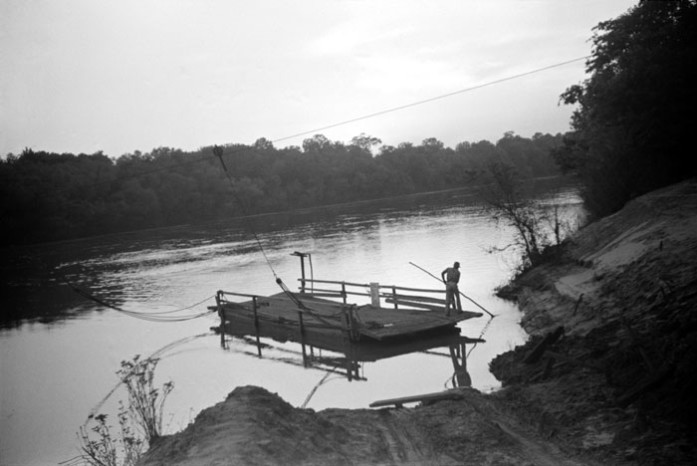A cable ferry is a ferry that is guided or propelled across a river or a large body of water by cables connected to both shores. This is the definition I found on Wikipedia and I don’t see how to put it differently. The cable ferry is also called chain ferry, swing ferry, floating bridge or punt. They used rope or chains (hence the name of “chain ferry”), but before the nineteenth century ended, the ropes or chains have been replaced with stronger wire cables.

Marion Post Wolcott – Old cable ferry between Camden and Gees Bend Alabama
[source: Wikipedia.org]
There are three types of cable ferry: the reaction ferry, which uses the power of the river to tack across the current; the powered cable ferry, which uses an engine or electric motors to wind itself across, and the fast-disappearing hand-operated type.
Powered cable ferries use powered cogs or drums on board the vessel to pull itself along by the cables. The cables or chains have a considerable amount of slack built into them, in order to sink below the surface as the ferry moves away, allowing other vessels to pass without becoming grounded, snared or trapped. Where a ferry carries both passengers and vehicles the car deck occupies the center (helping to balance the vessel) and two passenger areas are at the sides, over the tunnels for the chains and the engines. As the ferry cannot steer a ramp is built at both ends, and there is usually a set of controls facing in either direction.
Cable ferries are common where there is little other water-borne traffic that could get snagged in the cable or chains, where the water may be too shallow for other options, or where the river current is too strong to permit the safe crossing of a ferry not attached to the shore. Alignment of the platform at each end of the journey is automatic and, especially for vehicle ferries, safer than a free-moving ferry might be in bad conditions.
A special type are electrically powered overhead-wire ferries, which have an “on board” propulsion unit and can float free, but are connected to the overhead wire for power supply, using an electrical cable that slides along the wire as the ferry moves.
Cable ferries have been used to cross rivers and similar bodies of water since before recorded history. Examples of ferry routes using this technology date back to the 13th century.
The information in this post is based entirely on the correspondent Wikipedia article. Too much there, though…
If you like what you read, please subscribe to this blog by completing the form. If you want to help more, start by following us on Twitter, and like our page on Facebook. You don’t know what good things may happen. To lighten your day, check our pins on Pinterest, we can be friends there too. Oh, and if you need a really good looking blog attached to your site, or just for fun, to express your feelings more competitively, read this Own Your Website offer! Thank you very much.
Copyright © 2015 The Yacht Owner – Cable Ferry Definition
